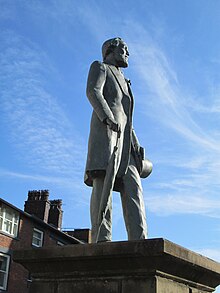Henry Doulton

Sir Henry Doulton (25 July 1820 – 18 November 1897) was an English businessman, inventor and manufacturer of pottery,[1] instrumental in developing the ceramics company of Royal Doulton.
Life
Born in Vauxhall, Henry was the second of the eight children of John Doulton (1793–1873), a pottery manufacturer, and his wife, Jane Duneau, a widow from Bridgnorth in Shropshire. His brother, Frederick Doulton, became Member of Parliament for Lambeth from 1862 until 1868. His father had become a partner in a pottery business in 1815 but Henry was the most academic of his children. Henry spent two years at the University College School where he developed a love of literature. His father had thought Henry the least likely to join the family business, perhaps being destined for a profession, but in 1835, he joined the firm, as did all his brothers other than Frederick.[2]
One of the first results of his many experiments was the production of good enamel glazes. In 1846 he initiated in Lambeth the pipe works, in which he superintended the manufacture of the drainage and sanitary appliances which helped to make the firm of Doulton famous.[1][3]
In 1870 the manufacture of "Art pottery" was begun at Lambeth,[4] using the skills of students from the Lambeth School of Art[5] (later the City and Guilds of London Art School). The company exhibited at the Centennial Exposition of 1876 in Philadelphia.[6]
In 1877, works were opened at Burslem, where almost every variety of porcelain and earthenware has been produced. Works have since been opened at Rowley Regis, Smethwick, St Helens, Paisley and Paris[citation needed]. After the Paris exhibition of 1878, Henry Doulton was made a Chevalier of the Légion d'honneur.[7]
In 1872, the Art department was instituted in the Doulton works, giving employment to both male and female artists, among whom such workers as George Tinworth and Misses Hannah and Florence Barlow obtained a reputation outside their immediate sphere.[7]

On 12 August 1887, Doulton received the honour of a knighthood,[8] and in 1885 he was awarded the Albert Medal by the Royal Society of Arts.[7]
Doulton died at his residence, 10 Queen's Gate Gardens, London, on 17 November 1897, and was buried at Norwood cemetery. The business was turned into a joint-stock company in 1899.[9]
After his death in London, he was placed in a mausoleum at West Norwood Cemetery appropriately constructed from red pottery tiles and bricks from the Doulton Works, which is now a Grade II Listed building.[10]
Family
In 1849, he married Sarah Kennaby. They had three children, Sarah Lillian (1852–), Henry Lewis (1853–1930), and Katherine Duneau (1856–1932). Sarah Kennaby Doulton died in 1888.[11] Sir Henry Doulton took an active interest, as almoner, in St Thomas' Hospital.[7]
References
- ^ a b Chisholm 1911, p. 449.
- ^ Clement (2004)
- ^ Engineers and Officials: An Historical Sketch of the Progress of "Health of Towns Works" (between 1838 and 1856) in London and the Provinces. 1856. London: E. Stanford. pp. 117-118.
- ^ Chisholm 1911, pp. 449–450.
- ^ History of City and Guilds of London Art School Archived 4 October 2011 at the Wayback Machine
- ^ Own, Our (7 April 1876). "Art at the Centennial" (PDF). The New York Times. p. 1.
- ^ a b c d Chisholm 1911, p. 450.
- ^ "No. 25733". The London Gazette. 26 August 1887. p. 4642.
- ^ Seccombe 1901.
- ^ Lambeth statutory list. Archived 30 September 2007 at the Wayback Machine Probably c1888 by Robert Stark Wilkinson, architect of the Doulton Pottery works on the Albert Embankment, for Doulton's wife. Small red bricks with red terracotta quoins, dressings and roof tiles...
- ^ "Sir Henry Doulton Dead" (PDF). The New York Times. 19 November 1897. p. 7.
Attribution:
 This article incorporates text from a publication now in the public domain: Seccombe, Thomas (1901). "Doulton, Henry". In Lee, Sidney (ed.). Dictionary of National Biography (1st supplement). London: Smith, Elder & Co.
This article incorporates text from a publication now in the public domain: Seccombe, Thomas (1901). "Doulton, Henry". In Lee, Sidney (ed.). Dictionary of National Biography (1st supplement). London: Smith, Elder & Co.- This article incorporates text from a publication now in the public domain: Chisholm, Hugh, ed. (1911). "Doulton, Sir Henry". Encyclopædia Britannica. Vol. 8 (11th ed.). Cambridge University Press. pp. 449–450.
Bibliography
- Clement, Alexander James. "Doulton, Sir Henry (1820–1897)". Oxford Dictionary of National Biography (online ed.). Oxford University Press. doi:10.1093/ref:odnb/7944. (Subscription or UK public library membership required.)
- Eyles, D. (1965). Royal Doulton, 1815–1965: The Rise and Expansion of the Royal Doulton Potteries. London: Hutchinson.
- Eyles, D.; Irvine, L. (2002). The Doulton Lambeth wares (2nr rev ed.). London: Richard Dennis. ISBN 0-903685-79-5.
- Eyles, D.; et al. (1994). Royal Doulton Figures: Produced at Burslem, Staffordshire, c1890-1994 (3rd rev ed.). London: Richard Dennis. ISBN 0-903685-35-3.
- Gosse, E., ed. D. Eyles (1970). Sir Henry Doulton: The Man of Business as a Man of Imagination. London: Hutchinson. ISBN 0-09-103590-2.
{{cite book}}: CS1 maint: multiple names: authors list (link)
External links
 Media related to Henry Doulton at Wikimedia Commons
Media related to Henry Doulton at Wikimedia Commons
